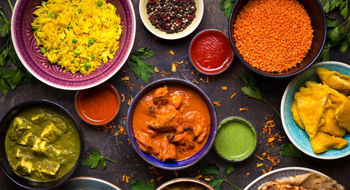New Delhi, Jun 2: Ever thought you would be consuming heavy metals or cigarette butts with your food? As a rule of thumb, foods are generally safe. However, there are things that get into food, which could shock and disgust you enough to keep away from food altogether.
What will surprise you further is that many of these things are permitted by the food safety authorities, but within limits. Some substances, like certain toxins, are naturally present in foods. And so, even if the food authorities wanted, they could not ban them totally.
Some of these ‘foreign’ substances might not be dangerous, but not even in your wildest imagination could you have thought that they could be on your plate, says Dr Saurabh Arora, founder, Food Safety Helpline.com.
1. Snack with maggots.
Next time you eat a burger or open sealed packs of foods, or cans of mushrooms and tomatoes, check carefully. It could be infested with maggots and insect eggs. Your cabbage and spinach could have caterpillar larvae in it. Believe it or not, a limited number of maggots are permitted in food, says Dr Arora.
2. Ever wondered what rats do in your food?
Rodents scavenge for food and rummage in food stocks. In fact, rodents could make stored foods their home if entry is not strictly prevented. Where there is laxity, rodent hair, urine and droppings enter foods and from there to your plate. So watch out as your food could be biologically contaminated.
3. They live in drains, dustbins and in your food.
Cockroaches, flies, insects of all kinds, and even spiders, and lizards can fall into food and are regarded as being highly dangerous if found in foods as they can carry bacteria from dustbins and drains to foods. The presence of rodents and insects is a food safety violation that could result in cancellation of license for food establishments.
4. What are cleaning agents doing in your food?
Cleaning agents like ammonia, bleach, dishwashing liquids and sanitizers can cause turmoil. People have had them with their coffee because the personnel forgot to rinse out the coffee machine thoroughly. Human error it could be but the carelessness in not rinsing and washing utensils or cooking surfaces thoroughly can lead to not only a bad taste but some stomach burning and even food poisoning. Cleaning agents need to be stored away from all food preparation areas and utensils. Cooking and food preparation surface areas must be cleaned, washed and sanitised only when food preparation is over and no food is outside. Such carelessness ruins reputations of food establishments.
5. Unseen dangers have roots.
Moulds and fungus grow on foods when the temperature is warm. The rainy season finds these in abundance in sauces, jams, jellies, cooked and processed meats and poultry, cheese, bread and even fruit. Surface moulds can be washed or dusted off but that does not mean they have gone away completely. The fungus has roots that go deep into foods and these are not visible to the naked eye. Dishcloths, towels, sponges and mops, if not kept clean, spread moulds which land up in your food. Avoid anything smelling musty and stale, and check vegetable and fruit stems to detect moulds.
6. Are you sure your milk products have no melamine?
Are you sure that the infant formula you are feeding your child with, or the chocolate and frozen yogurt you are eating is free of melamine? Melamine is synthetic material used to make plastic tableware and dishware, adhesives and even whiteboards. So what’s it doing in your food? Water is often mixed into milk and such milk loses proteins. So to enhance the content of protein, melamine is mixed in it. Products made from milk could have melamine which can damage the kidneys permanently.
7. Packaging infuses chemicals into food.
Antimony and tin are used in packaging materials from where they can enter food. Foils, cans, pans and storage containers have chemicals which can be released from them into food at low levels. When ingested, they cause various health problems.
8. You could be ingesting heavy metals.
Copper, brass, cadmium, lead, zinc, mercury and even arsenic could be in your food. Metals leach into foods from the environment and from utensils used for cooking and serving food. Cracked or chipped pewter dishes, pottery dishes with glazed lead, or those pretty enamelled dishes you cook and serve food in can leave lead or cadmium in your foods and can even react with acidic foods like tomatoes, orange juice and pickles. Copper cooking utensils, buckets and tubs made from galvanised metals like zinc, and plumbing pipes also introduce metals into foods. Mercury and arsenic can reach foods through water and cadmium and lead from soil. All these heavy metals can cause toxicity when ingested and could even damage the liver, kidneys, central nervous system and blood, while mercury can cause sensory, visual and auditory problems also. Since chemicals cannot be seen, adequate and regular food testing is required to ensure that foods are free from these elements at all points in the food chain.
9. Tea with a taste of iron.
Iron filings can enter tea when it is processed as particles escape into tea from the wear and tear of iron machinery. Iron remains in the body and though some iron is good for the body, it could become dangerous and lead to heart problems if you are a tea addict and drink copious amounts of it. The permissible limit for iron filings in tea in India is presently 150 mg per kilogram of tea.
10. Human beings leave their own stamp on foods.
While human hair found in food might not be as hazardous as animal hair, but their presence in food indicates that the establishment lacks in good hygienic practices. Besides hair; nails, false nails, nail polish, pieces of jewellery, paper napkins and even cigarette butts can enter food and have been found, more often than anyone would like to admit. All personnel working in the food service industry need to be made aware of these hazards and instructed and trained to follow good hygiene practices.
11. Mice and horse in your processed meat.
Animal hair or chipped pieces of bone can be naturally present in meat food products. Perhaps what you may not be aware of is that whole mice can sometimes be churned into foods during processing. Unscrupulous manufacturers add horse and even rat meat to canned meat food products to cut costs, especially those imported, as some countries permit horse meat.
12. Extraneous materials that can break your teeth.
They say sticks and stones won’t break bones but stones in food might break your pearly whites. You must have seen dirt, mud, manure, leaves, twigs and other filth and even insect excreta in some raw grains and other agricultural products. While some of these can be removed by picking them out, what about insect excreta? When raw materials are processed into cereals and bakery products, do these remain or have they been cleaned before processing?
13. What’s cooking, metal or glass?
Metal fragments from worn or chipped equipment and containers enter food products during processing. However, glass, plastic and metal pieces from glass tumblers, edges of badly opened tin cans, and carelessly opened caps on foods, and even shattered light bulbs fall into food without anyone realising it. Wood pieces from wooden surfaces or chopping boards slip into food too. Even a small piece of any of these substances can cause major problems if swallowed. Most establishments use shatterproof bulbs and open tin cans and bottles away from foods being cooked.
14. Sand and sawdust special.
Have you felt that grit on your tongue? It could be sand in your salt, soup and coffee whitener. Sand is mixed in powdered foods as sand absorbs moisture and prevents clumping. Sawdust is used for the same reason in foods like shredded cheese. It also makes low-fat ice cream creamy and ready-to-drink milkshakes smooth.
15. Are these food additives really permitted?
The fruit juice you enjoy so much could have sulphites. Sulphites are deliberately added to fruit juices, in some soft drinks, instant tea vinegar and wine to keep them tasting fresh. While preservatives and flavour enhancers improve the looks and taste of foods yet some of them could cause allergic reactions.
16. Of hormones and antibiotics.
Livestock are given antibiotics and growth hormones in their feeds so they can remain healthy and grow bigger quickly. If you are a non-vegetarian, you could find these growth hormones and antibiotics in the animal meats which you eat. Eating animal meats that contain antibiotic makes you resistant to them.
17. From plants to your plate.
Residues of pesticides, herbicides and chemical fertilizers used during the agricultural process easily find their way into food. Pesticides may leave residues on the skins and surface of fruits and vegetables. Residues of pesticides and herbicides, over a period of time, can affect the central nervous system, respiratory and gastrointestinal system.
18. Gelatine: veg or non-veg?
Some vegetarian foods like certain cereals could contain animal gelatine which is used as a binding agent so that the sugar sticks to the cereal. Read the labels minutely if you are a vegetarian or you could find you’ve just eaten animal bone and skin as some gelatine are made from these.
19. Carcinogens in your foods.
Bright coloured foods look attractive but the truth is that synthetic dyes like Red 3 and Citrus Red 2, Blue 1, Blue 2, Green 3, Red 40 and Yellow 6 are carcinogenic and could cause various kinds of cancer and allergic reactions too.
20. What does your chewing gum contain?
If you are one of those who loves to pop a chewing gum into your mouth, then you could actually be eating a secretion from sheep wool called Lanolin. This additive is used in chewing gum because it has an oily texture which makes it easy to chew that gum.






Comments
Add new comment